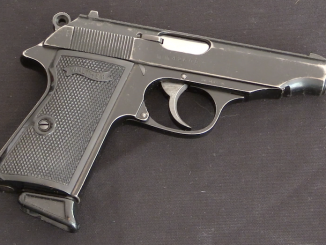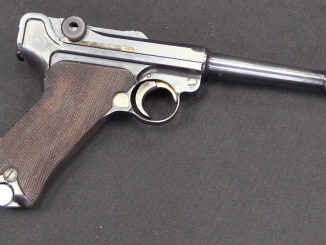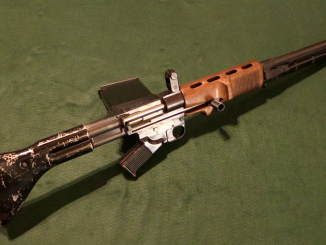In order to circumvent Versailles Treaty restrictions on arms manufacture, the German Rheinmetall firm purchased a small Swiss company called Solothurn Waffenfabrik in 1929, allowing it to route its business through Switzerland instead of Germany. One of its first products was the S1-100 submachine gun, designed by Louis Stange. This was an excellent example of a first generation submachine gun, made to very high standards with an elaborately milled receiver. They were expensive, premium guns in the 1930s, and were sold worldwide, including contracts to Bolivia, El Salvador, Japan, Thailand, Uruguay, Portugal, Austria, and more. To accommodate these different client militaries, the gun was offered in 9mm Steyr, 7.63mm Mauser, 7.65 Parabellum, and .45 ACP.
This particular example appears to be a Japanese one, purchase in the mid 1930s to equip some elite Japanese units like the Special Naval Landing Force. It is in 7.62mm Mauser and shows the D/E selector markings one would expect from that contract (other contracts used markings with Spanish or Portuguese abbreviations). This gun would have been captured by an American serviceman during World War II and brought back, to be registered later in the 1968 amnesty. It is all original, with the exception of what appears to be a replaced barrel.




I wonder if this was actually a Chinese gun, as Mauser pistols were popular during the warlord era. I am probably wrong but if Japanese troops used such guns they anticipated ammunition would be in good supply once in China…
Without requirement of common cartridge with automatic pistol, from available:
9mm Steyr, 7.63mm Mauser, 7.65 Parabellum, and .45 ACP
7.63 seems to be best, offering flattest trajectory.
I know the S1-100 was “offered” in .45 ACP, but I’ve never seen any evidence that any were ever actually made in that chambering.
Similarly, the 1939 “World’s Fair” edition of the Stoeger catalog announcing the Walther HP (P38) automatic pistol states that it could be had in 9mm Luger, 7.65mm Luger and again in .45 ACP. The only .45 caliber P38s I’ve noticed were those made by John Martz almost half-a-century later.
Oddly, the Madsen M50 SMG is normally thought of as strictly a 9 x 19mm, but the Brazilian license-built INA copy was in fact a .45 ACP. And most foreign copies of the U.S. M3 “Grease Gun” (Taiwanese Type 37, etc.) were in 9 x 19.
IMPO, on purely technical/tactical grounds, there’s not much point in building an SMG in calibers other than 9 x 19mm Parabellum or 7.62 x 25mm Tokarev. The latter can actually be quite useful, assuming you are willing to use “+P+” ammunition like the Czech loadings for the vz24/26 SMGs, which deliver ballistics close to those of the U.S. .30 Carbine round.
cheers
eon
“on purely technical/tactical grounds, there’s not much point in building an SMG in calibers other than 9 x 19mm Parabellum or 7.62 x 25mm Tokarev”
Far fetched statement. Spain used quite long 9×23 Largo sub-machine guns. Also, I would not discard option for .22 rim-fire sub-machine gun:
https://modernfirearms.net/en/submachine-guns/yugoslavia-submachine-guns/mgv-176-eng/
however with disclaimer that it has its limitations against 9×19.
Nonetheless, I agree .45 Auto is ill-suited for application in sub-machine guns.
The only really practical application for .45 ACP is in suppressed weapons. Since other pistol cartridges rely on supersonic velocity to achieve kinetic energy dump at the target, they cannot be effectively suppressed without losing KE dump potential by reducing velocities below the speed of sound.
The .45 ACP, which is subsonic to begin with, does not have this problem. Other cartridges used have had their projectile weights increased to attempt to get KE back up even at subsonic velocities. Which means they end up trying to duplicate .45 ACP ballistics in all respects.
The ideal “suppressed weapon” would probably be something like the H&K Mk 23 handgun, a suppressed .45 ACP locked-breech self-loader. It should ideally be equipped with a slide lock to keep the breech shut, thereby eliminating the sound of the action cycling.
A revolver like the Dan Wesson, with a barrel-cylinder gap adjustable to a minimum .005 inch, and chambered for a cartridge which can deliver effective KEs over 400 FPE at velocities of around 1,000 f/s (such as a “medium velocity” .44 Magnum 250-grain LSWC at 1,000 F/S MV and 550 FPE), would be even more practical.
The Guide Lamp Co.-made suppressed M3 “Grease Gun” of WW2 was very nearly the perfect suppressed weapon, with only the British DeLisle carbine (also a .45 ACP) and the various iterations of the Welrod family being superior to it.
cheers
eon
“ideal “suppressed weapon” would probably be something like the H&K Mk 23 handgun, a suppressed .45 ACP locked-breech self-loader. It should ideally be equipped with a slide lock to keep the breech shut, thereby eliminating the sound of the action cycling. ”
Soviet PSS http://modernfirearms.net/en/handguns/handguns-en/russia-semi-automatic-pistols/pss-besshumnyj-eng/ was made to work more silent without need to turning it into repeating pistol.
Russian answer to cartridge which could be suppressed in more classical way that above-mentioned PSS is 9×39: http://gunrf.ru/rg_patron_9x39_eng.html
it is effect of sub-sonic velocity requirement and penetration requirement
Isn’t it possible to find out who registered it, and maybe backtrack the provenance that way?
Nope. It is considered PII, a FOIA request will simply give you a highly retracted form 4 or equivalent with the date it entered the NFA registry.
The bayonet lug maybe give some clue, try a Japanese type 30 bayonet on it…. unless they came with their own unique bayonet…
A somewhat over-built firearm.
The Japanese must have liked the design; the later Type 100 looks like a simplified version.
Over-built is an understatement. Let’s consider that the manufacturing took place in a Swiss firm, even if the management answered to a German firm. The Swiss had a very high standard of manufacturing, and I bet this is because of the limits on available materials (all of the iron ore had to be imported, if I’m not mistaken). Too bad they didn’t master stamping at the time, or tons of their guns could have been made with less wasted material. But I digress. Do recall that Japanese long arms were hardly considered fragile, especially since even the light machine guns were expected to handle the stress of bayoneting someone to death. Seeing a foreign pistol-caliber long arm sturdy enough for the job must have gotten the Army and Navy wondering if a domestic counterpart could be made. Cue Nambu!
“Cue Nambu!”
Photo of experimental Nambu sub-machine gun from 1933, can be seen here:
https://strangernn.livejournal.com/1677924.html
ergonomic-wise it seems to be more influenced by Thompson sub-machine gun
That top cover over action is clever; it could be duplicated even today, for good use. Good piece of history.
I am glad Ian did not try to “Franchise” designer’s name this time (actually Shtange; with -g- half silent would sound even better).
In case if you want to know how word is pronounced in foreign language, this:
http://www.acapela-group.com/
might be helpful, obviously it is not giving ONE AND ONLY PROPER pronunciation, especially considered that Deutsch vary region-by-region (as in most of 19th century, on lands now being parts of Germany, there was not single country [understand as recognized international policy entity] but a lot smaller countries)
I remember seeing in a newspaper article some years ago that Thailand was in the habit of executing criminals (read drug runners) using what the paper described as an ‘antique’ submachine gun. The photo in the article showed what looked like one of these equipped with some sort of simple timer on the trigger, and the condemned criminal seated on a chair in front of it. Interesting!
“You dirty rats! I refuse to be done in by a clockwork executioner!”